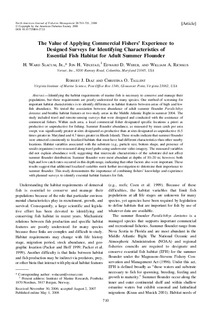The value of applying commercial fishers' experience to designed surveys for identifying characteristics of essential fish habitat for adult summer flounder
Journal article, Peer reviewed
Permanent lenke
http://hdl.handle.net/11250/108286Utgivelsesdato
2008-06Metadata
Vis full innførselSamlinger
- Articles [3001]
Originalversjon
http://dx.doi.org/10.1577/m06-272.1Sammendrag
Identifying the habitat requirements of marine fish is necessary to conserve and manage their populations, but these requirements are poorly understood for many species. One method of screening for important habitat characteristics is to identify differences in habitat features between areas of high and low fish abundance. We tested the association between abundance of adult summer flounder Paralichthys dentatus and benthic habitat features at two study areas in the Middle Atlantic Bight in summer 2004. The study included trawl and remote-sensing surveys that were designed and conducted with the assistance of commercial fishers. Within each area, a local commercial fisher designated specific locations a priori as productive or unproductive for fishing. Summer flounder abundance, as measured by mean catch per area swept, was significantly greater at sites designated as productive than at sites designated as unproductive (6.5 times greater in Maryland and 4.7 times greater in Rhode Island). These results indicate that summer flounder were attracted consistently to localized habitats that must have had different characteristics than other nearby locations. Habitat variables associated with the substrate (e.g., particle size, bottom shape, and presence of sessile organisms) were measured along trawl paths using underwater video imagery. The measured variables did not explain abundance well, suggesting that microscale characteristics of the substrate did not affect summer flounder distribution. Summer flounder were most abundant at depths of 10-20 m; however, both high and low catch rates occurred in this depth range, indicating that other factors also were important. These results suggest that additional localized variables merit further investigation to determine their importance to summer flounder. This study demonstrates the importance of combining fishers' knowledge and experience with planned surveys to identify essential habitat features for fish.
